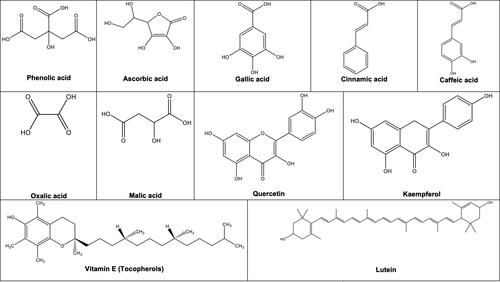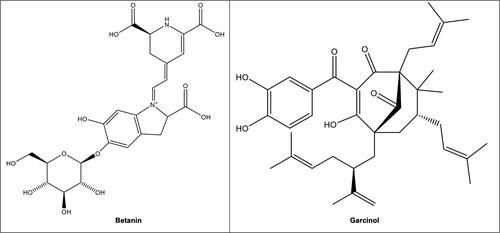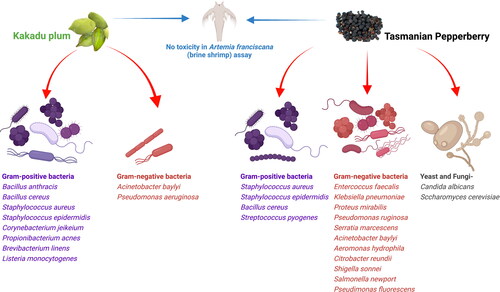Figures & data
Table 1. Nutritional composition of common commercially grown native Australian fruits and vegetables.
Figure 1. Some of the common phytochemicals and antioxidants found in Australian native fruits and vegetables.

Table 2. Various phytochemicals identified in common Australian native fruits and vegetables.
Table 3. Antioxidants reported in Australian native fruits and vegetables.
Figure 2. Structures of betanin in seaberry saltbush (Rhagodia candolleana) and the pigface (Carpobrotus rossii) (Njume, McAinch, and Donkor Citation2020); garcinol in yellow mangosteen (Garcinia dulcis) (Deachathai et al. Citation2005, John et al. 2020).

Table 4. Activity of Australian native fruits and vegetables against cancer cell lines.
Table 5. Australian native fruits and their interactions with gut microbial communities.
Figure 3. Anticancer activity of some Australian native fruits through induction of apoptosis. Muntries (Kunzea pomifera) and native currant (Antidesma erostre): ↑ caspase 3 mediated apoptosis in the HL-60 acute promyelocytic leukaemia cells (Tan, Konczak, Ramzan, et al. 2011a). Native tamarind (Diploglottis australis), desert lime (Citrus glauca), bush tomato (Solanum centrale) and lemon aspen (Acronychia acidula): ↑ caspase 3-mediated apoptosis by ↑ Bax in the HeLa cervical and the CaCo2 colorectal cancer cell lines (Joseph Sirdaarta et al. Citation2016). Illawarra plum (Podocarpus elatus): ↑ caspase 3-mediated apoptosis by ↑ SERT 1 [Sirtuin 1] expression which ↑ starvation-induced autophagy in the HeLa cervical and the CaCo2 colorectal cancer cells (Joseph Sirdaarta et al. 2016) and ↓ hTERT expression that affects cell telomere length and ↑ HDAC activity that silence the genes required for tumour. progression in the HT-29 human colorectal cancer cells (Symonds, Konczak, and Fenech 2013a). Kakadu plum (Terminalia ferdinandiana): ↑ caspase cascade (3, 7, 9) mediated apoptosis and activated of PARP [poly (ADP-ribose) polymerase] that induces intrinsic apoptotic pathways in the HL-60 acute promyelocytic leukaemia cells (Tan, Konczak, Ramzan, et al. 2011a) and the CaCo2 colorectal cancer cell lines (Shalom and Cock 2018a). Lemon aspen (Acronychia acidula): ↑ caspase cascade (3, 7, 8, 9) mediated apoptosis by ↑ DR4 and DR5 cell death receptors that facilitate the selective elimination of malignant cells through the ↑ apoptosis and ↓ the expression of PCNA (causing lethal DNA damage) and Cyclin D1 (inducing the cell-cycle arrest) in human lung cancer, pancreatic and HOS [Human osteo-sarcoma] carcinoma cell lines. ↑ of the p21 also inhibits the cell cycle progression (Joseph Sirdaarta et al. 2016)
.
![Figure 3. Anticancer activity of some Australian native fruits through induction of apoptosis. Muntries (Kunzea pomifera) and native currant (Antidesma erostre): ↑ caspase 3 mediated apoptosis in the HL-60 acute promyelocytic leukaemia cells (Tan, Konczak, Ramzan, et al. 2011a). Native tamarind (Diploglottis australis), desert lime (Citrus glauca), bush tomato (Solanum centrale) and lemon aspen (Acronychia acidula): ↑ caspase 3-mediated apoptosis by ↑ Bax in the HeLa cervical and the CaCo2 colorectal cancer cell lines (Joseph Sirdaarta et al. Citation2016). Illawarra plum (Podocarpus elatus): ↑ caspase 3-mediated apoptosis by ↑ SERT 1 [Sirtuin 1] expression which ↑ starvation-induced autophagy in the HeLa cervical and the CaCo2 colorectal cancer cells (Joseph Sirdaarta et al. 2016) and ↓ hTERT expression that affects cell telomere length and ↑ HDAC activity that silence the genes required for tumour. progression in the HT-29 human colorectal cancer cells (Symonds, Konczak, and Fenech 2013a). Kakadu plum (Terminalia ferdinandiana): ↑ caspase cascade (3, 7, 9) mediated apoptosis and activated of PARP [poly (ADP-ribose) polymerase] that induces intrinsic apoptotic pathways in the HL-60 acute promyelocytic leukaemia cells (Tan, Konczak, Ramzan, et al. 2011a) and the CaCo2 colorectal cancer cell lines (Shalom and Cock 2018a). Lemon aspen (Acronychia acidula): ↑ caspase cascade (3, 7, 8, 9) mediated apoptosis by ↑ DR4 and DR5 cell death receptors that facilitate the selective elimination of malignant cells through the ↑ apoptosis and ↓ the expression of PCNA (causing lethal DNA damage) and Cyclin D1 (inducing the cell-cycle arrest) in human lung cancer, pancreatic and HOS [Human osteo-sarcoma] carcinoma cell lines. ↑ of the p21 also inhibits the cell cycle progression (Joseph Sirdaarta et al. 2016).](/cms/asset/6a86a9a1-9cec-42a1-9482-6fdf6366ee67/bfsn_a_2057913_f0003_c.jpg)
Figure 4. Anti-inflammatory activity of Australian native fruits and their constituents mediated through different molecular pathways of oxidative stress. Kakadu plum (Terminalia ferdinandiana): ↓ inflammatory enzymes- cyclooxygenase-2 (COX-2) and inducible nitric oxide synthase (iNOS), ↓ nitric oxide (NO) and Prostaglandin E2 (PGE2) (Tan, Hou, et al. Citation2011), ↑ the nuclear erythroidrelated factor 2 (Nrf2)/ Kelch-like ECH-associated protein 1 (Keap1) (Tan, Konczak, Ramzan, Zabaras, et al. 2011), inhibited phosphorylation and degradation of inhibitor of kappa B-alpha (IкBα) (Tan, Hou, et al. Citation2011). Illawarra plum (Podocarpus elatus): ↓ inflammatory enzymes- cyclooxygenase-2 (COX-2) and inducible nitric oxide synthase (iNOS) (Tan, Hou, et al. Citation2011). Cyanidin 3-glucoside from Queen Garnet plum (Prunus salicina): Inhibited the NF-κB signalling pathway through the protection of IκBα, ↓ NF-κB and its translocation into the nucleus, ↓ NF-κB p65 and ↓ iNOS, ↑ endogenous antioxidant enzymes and ↑ Nrf2 signalling pathway activity.

Figure 5. Antimicrobial activity of two most investigated Australian native fruits – Kakadu plum (Terminalia ferdinandiana) and Tasmanian Pepperberry (Tasmannia lanceolata) (Sirdaarta et al. Citation2015; Mitchell Henry et al. Citation2016; Cheesman et al. Citation2019; McManus et al. Citation2017; Winnett et al. Citation2014). These two fruits showed no toxicity in the Artemia franciscana (brine shrimp) assay.

